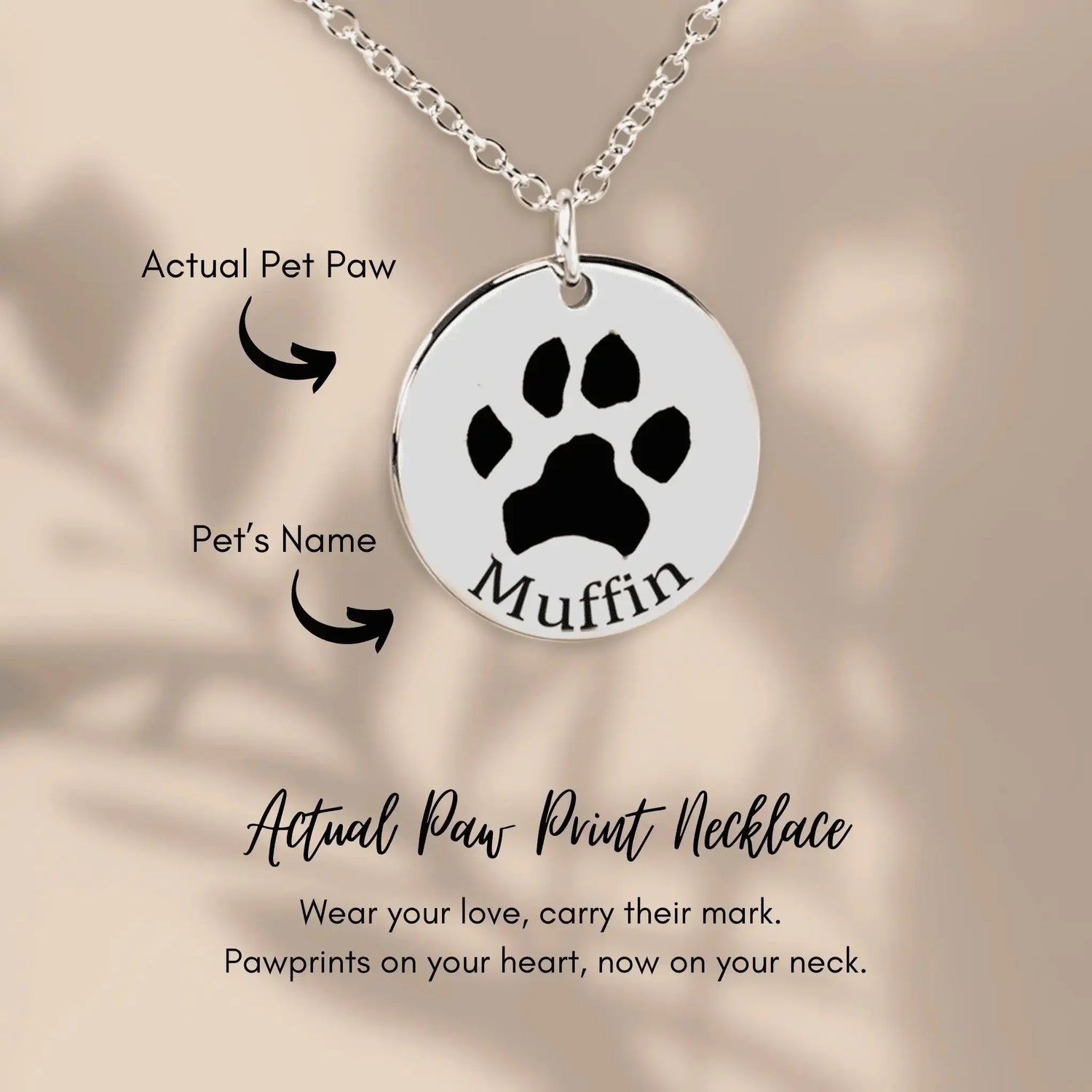How to Reduce Cat anxiety: A Paw-sitive Guide to a Calm Kitty
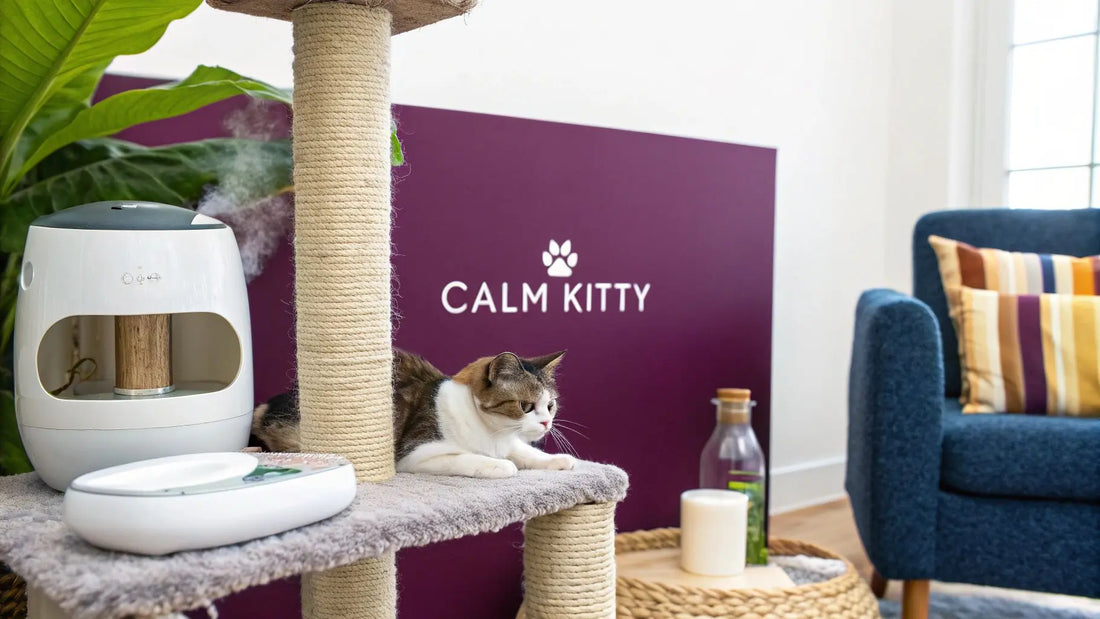
Figuring out how to help your anxious cat starts with putting on your detective hat. 🕵️♀️ The whole game is about spotting your cat's specific triggers and symptoms—which can be anything from over-grooming to hiding—and then making smart, targeted changes to their environment. Think of it as learning to speak their meow-velous language to bring back their inner peace. 🧘♀️
Why Is My Cat So Anxious?
Hey there, fellow cat paw-rents! Our resident expert, Floofie, knows firsthand that a stressed-out kitty can throw off the whole vibe of a home. Learning to read the subtle signals your cat is sending is the absolute first step to helping them feel safe and secure again. An anxious cat isn't trying to be a pain; they're showing you they genuinely need help.
Cats are absolute pros at hiding their stress. It's an old instinct from their wild ancestors—showing weakness makes you a target. That instinct is still alive and well in our domestic floofs, which means their anxiety signs can be super easy to miss if you don't know what to look for.
Spotting the Sneaky Signs of Stress
Is your normally fluffy cat suddenly grooming bald patches on their belly? Maybe your social butterfly has turned into a professional hide-and-seek player? These aren't just funny quirks. They're often little cries for help. 😿
Other common signs to watch for include:
- Litter Box Oopsies: Suddenly going outside the litter box is a classic red flag that something's wrong.
- Extra Chattiness: More meowing, yowling, or hissing than usual can definitely signal distress.
- Getting Feisty: Lashing out at you or other pets often comes from a place of fear and anxiety.
- Picky Eating: A worried cat might suddenly turn their nose up at their favorite food.
To help you connect the dots, here’s a quick rundown of common signs and what might be causing them.
Quick Guide to Cat Anxiety Signs and Triggers
This table can help you quickly match a behavior you're seeing with a potential cause in your cat's environment.
| Anxiety Sign | What It Looks Like In Your Cat | Common Potential Trigger |
|---|---|---|
| Hiding | Suddenly spending more time under beds, in closets, or avoiding family. | Loud noises, new people or pets in the home, changes in routine. |
| Over-Grooming | Licking or chewing one spot excessively, leading to bald patches or irritated skin. | Boredom, lack of stimulation, stress from another pet. |
| Aggression | Uncharacteristic hissing, swatting, or biting towards people or other animals. | Feeling cornered, resource guarding (food, toys), pain. |
| Inappropriate Urination | Peeing outside the litter box, often on soft surfaces like beds or laundry. | Dirty litter box, conflict with another cat, medical issues. |
| Changes in Appetite | Eating significantly less or more than usual. | A new food, stress from environmental changes, dental problems. |
Seeing your cat's behavior on this list can feel worrying, but it's the first step toward finding a solution!
Common Triggers in a Cat's World
So, what's causing all this kitty chaos? The triggers can be surprisingly simple things we barely notice. Loud noises are a big one. In fact, studies show that unexpected sounds like fireworks trigger anxiety in more than 77% of pets with noise sensitivities.
Social situations are another huge factor. Over half of cat owners report that run-ins with other animals make their cats anxious. If you want to dive deeper, you can check out more pet anxiety research to see just how common these issues are.
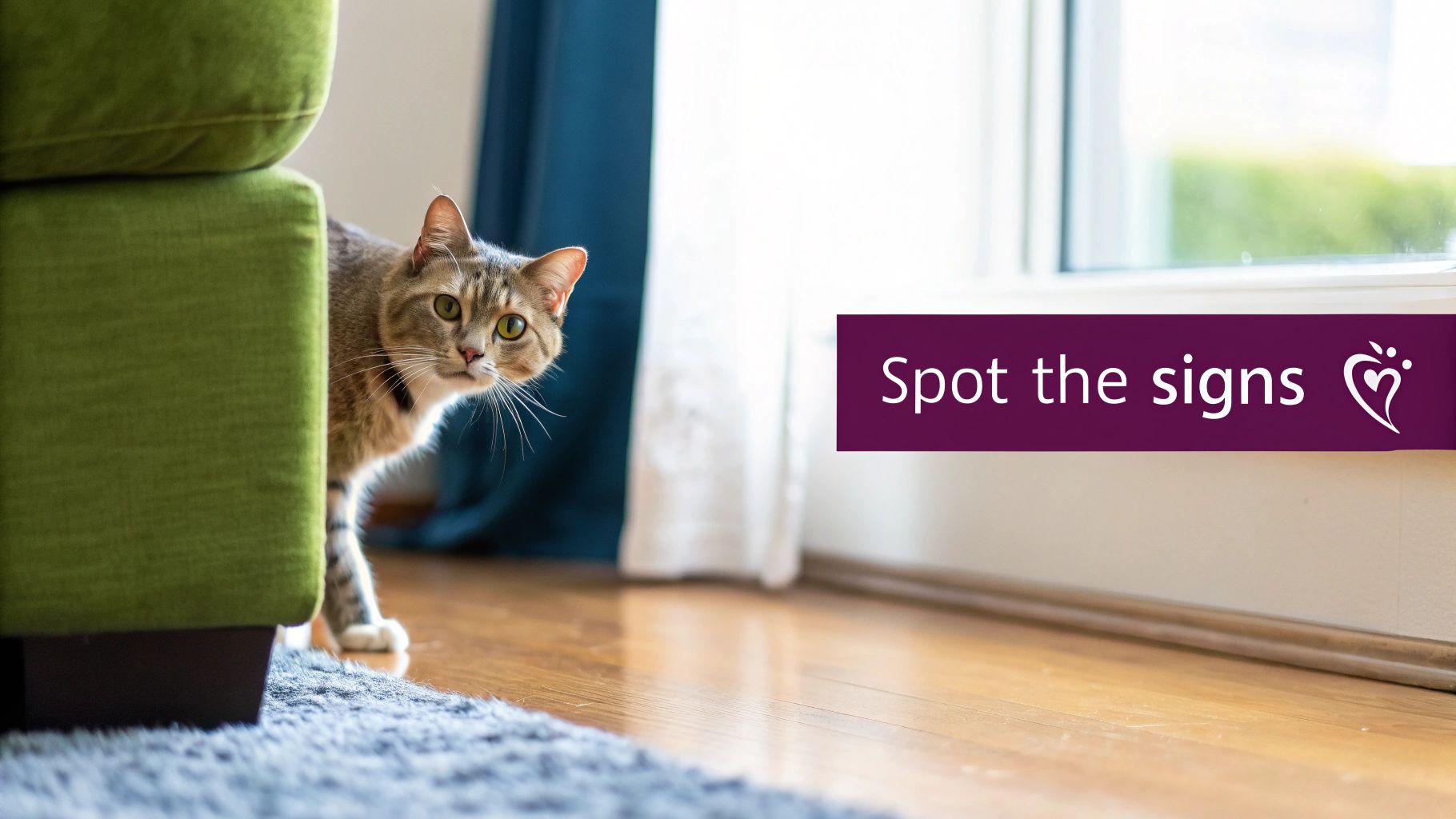
Floofie's Tip: "Meeeow! Remember, what seems like a tiny change to you can feel like an earthquake to your cat! A new piece of furniture, a different work schedule, or even a new air freshener can totally mess with their sense of security."
Beyond the obvious, even subtle shifts can unsettle a sensitive cat. A new roommate moving in, rearranging the living room, or a stray cat hanging out in the yard can all make your cat feel on edge.
Recognizing these potential stressors is your superpower. Now that you know what to look for, we can get into the fun part: creating the ultimate kitty sanctuary! 💖
Creating a Cat-Friendly Sanctuary at Home
Alright, now that you know how to spot the subtle signs of stress, let's get to the fun part—turning your home into the ultimate kitty paradise! 😻 Our mascot, Floofie, is here to tell you that building a true cat-friendly sanctuary is one of the best things you can do for an anxious cat. It’s all about "catifying" your space to give them a sense of control and security.
A cat’s world revolves around their territory. To feel secure, they need to be able to survey their kingdom from up high. Put yourself in their paws for a second: the ground feels vulnerable, but a high perch? That's a power position. It's a deeply instinctual need for safety.
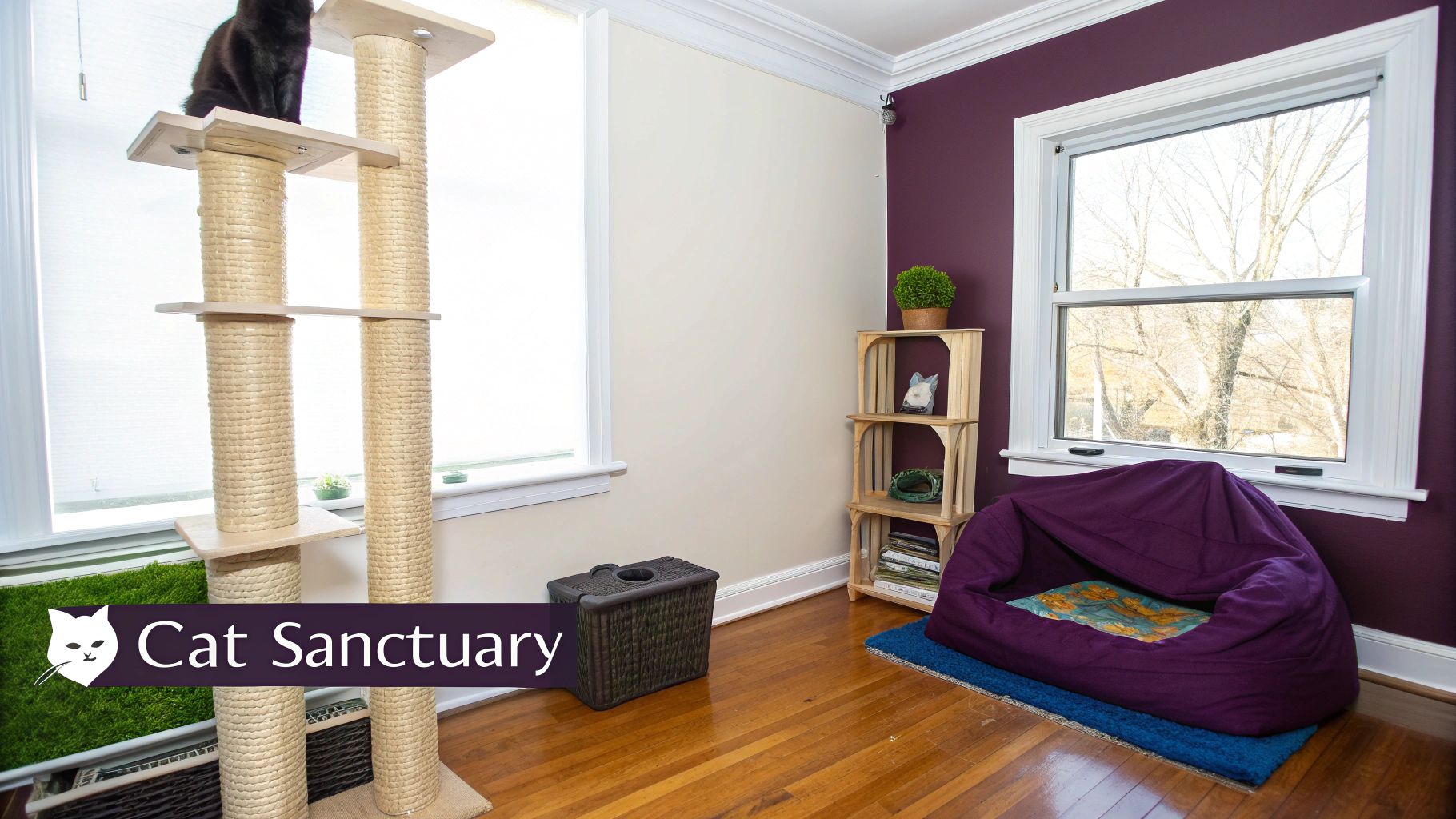
Go Vertical Darling
One of the quickest ways to dial down cat anxiety is to add more vertical space. This creates safe vantage points and much-needed escape routes, which are absolute game-changers for a nervous kitty. You can instantly boost your cat’s confidence with just a few simple additions.
- Majestic Cat Trees: A tall, sturdy cat tree isn't just furniture; it's a castle. Look for one with multiple levels and cozy cubbies to give them options for climbing, scratching, and snoozing.
- Wonderful Wall Shelves: These are fantastic for turning your walls into a feline superhighway! Stagger them to create an engaging climbing path that leads to a comfy, high-up perch.
- Perfect Window Perches: Give your cat a front-row seat to their favorite channel: the great outdoors. A secure window perch offers hours of entertainment and a sunny spot for a nap.
Even if you're working with a smaller space, creative furniture solutions can make a huge difference. There are some great ideas out there for optimizing furniture in small apartments that work for pets, too.
Create Cozy Hideaways
Every single cat, but especially an anxious one, needs a "do not disturb" zone. These are designated hideaways where they can retreat when they feel overwhelmed by visitors, loud noises, or just... life. A covered cat bed, a simple cardboard box with a fluffy blanket, or even the space under your bed can become a cherished safe spot.
Floofie's Tip: "My favorite hideout is my CuddleCloud Calming Donut Bed! It’s so soft and cushy, it feels like a big warm hug. Make sure your human never forces you out of your safe space—it’s the kitty code of honor!"
Keep the Peace in a Multi-Cat Home
If you have more than one floof, competition over resources can be a massive source of stress. Imagine having to share your dinner plate and your bathroom with a roommate you didn't choose. Yikes. 😬
To keep anxiety low in a multi-pet household, spread the resources out. This means multiple food bowls, water stations, and litter boxes in different areas of the house. The golden rule is one litter box per cat, plus one extra. This prevents one cat from "gatekeeping" a resource and bullying another. For even more ideas on setting up the perfect space, check out our guide to fabulous cat room decor.
Finally, a pheromone diffuser can be a lifesaver. Products like Feliway mimic a cat's natural calming facial pheromones, creating a continuous, invisible signal of safety and comfort throughout your home. It's an effortless way to tell your cat, "You're safe here."
Using Play and Enrichment to Build Confidence
A bored cat is an anxious cat. It’s a simple truth Floofie knows all too well. 🙀 Deep down, our little house panthers are still wired like the apex predators they once were. When all that instinctual energy has nowhere to go, it can easily curdle into stress and anxiety. The best-kept secret to a confident, happy kitty is tapping into the therapeutic power of play!
Letting them channel their inner hunter isn't just a bit of fun; it's a core need. Interactive play burns off that nervous energy, keeps them physically fit, and—most importantly—gives your cat a massive sense of accomplishment. When they successfully "hunt" a toy, it teaches them they can make things happen in their world. That's a huge confidence booster.
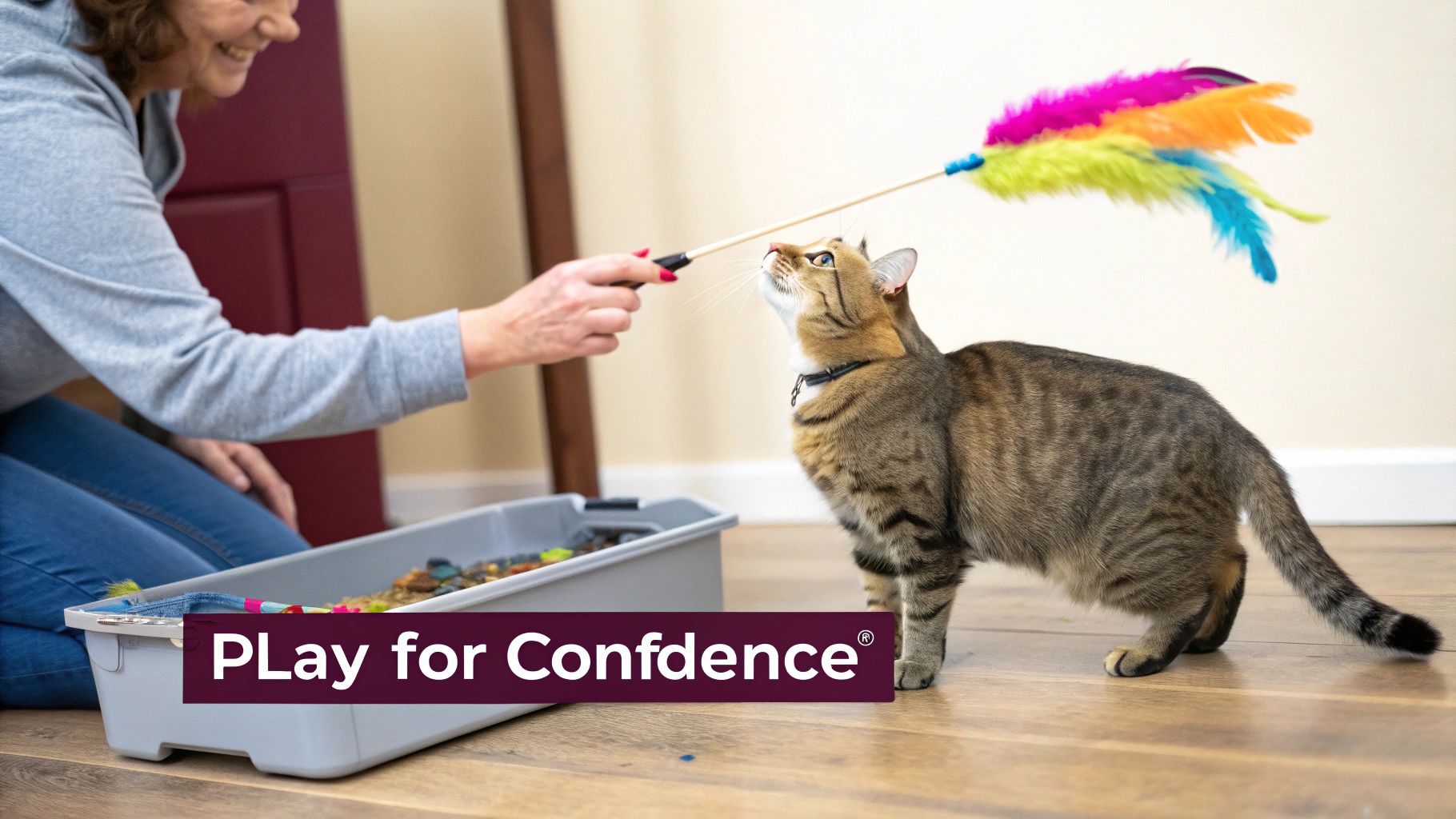
A Daily Dose of Play
The real magic is in the routine. Think of it as your cat's daily "play prescription." You don't need to block out huge chunks of your day for this. In fact, two or three 10-15 minute playtimes are way more effective than one long, exhausting session.
This consistency creates a predictable, positive part of their day they can actually look forward to. It helps dial down their anxiety because they know something good is coming.
"A wiggle worm a day keeps the worries away! My human knows my pounce-and-pounce routine is non-negotiable. It makes me feel like the king of my castle!" 👑 - Floofie
Just remember the golden rule: always let your cat "win" at the end by catching their prey. Follow it up with a high-value treat to complete the natural hunt-catch-eat cycle. This simple sequence is incredibly satisfying for a cat’s brain and cements that positive feeling about playtime.
Choosing the Purrfect Toys
Not all toys are created equal in the eyes of a cat. To really get their hunter instincts firing, you need toys that move and act like real prey.
- Feather Wands: These are the gold standard for a reason. They flutter, twitch, and zip around like a bird, which drives most cats absolutely wild.
- Laser Pointers (With a Caveat): Cats love chasing that elusive red dot, but it can lead to serious frustration since there's nothing to physically catch. If you use one, always finish the game by switching to a physical toy they can pounce on and capture.
- Puzzle Feeders: These are brilliant. They turn mealtime into a stimulating brain game. Instead of just getting a free lunch, your cat has to problem-solve to get their food, which is a fantastic boredom-buster.
If you're looking for more inspiration, check out the awesome toys in the FloofChonk store!
More Than Just Toys: Sensory Enrichment
A truly enriched environment engages all of your cat's senses, not just their pounce-and-chase drive. Think about introducing sensory experiences that connect them to the big, exciting world beyond your walls.
A secure "catio" or even just a sturdy window perch can provide hours of bird-watching entertainment—we call it "cat TV" for a reason! You can also bring the outdoors in with cat-safe plants like catnip or silver vine. For many cats, these herbs provide a burst of playful energy followed by a state of blissful calm. It's like a mini spa day for your feline friend! 🌿
Managing Stressful Events Like Vet Visits
Vet visits, thunderstorms, a house full of party guests—what do they all have in common? For an anxious cat, they're the stuff of nightmares. 👻 These high-stress situations can feel like a horror movie marathon, but our mascot Floofie knows that a little prep work goes a long way in helping them keep their cool.
Let's put together a toolkit for navigating these tricky moments with confidence.
Turning the Carrier Into a Happy Place
For most cats, the dreaded carrier is the first clue that something weird is about to happen. It only comes out right before a car ride or a trip to the vet, creating an instant, negative association.
The good news? We can flip that script. We can turn that carrier from a scary box into a cozy, safe den they actually want to be in.
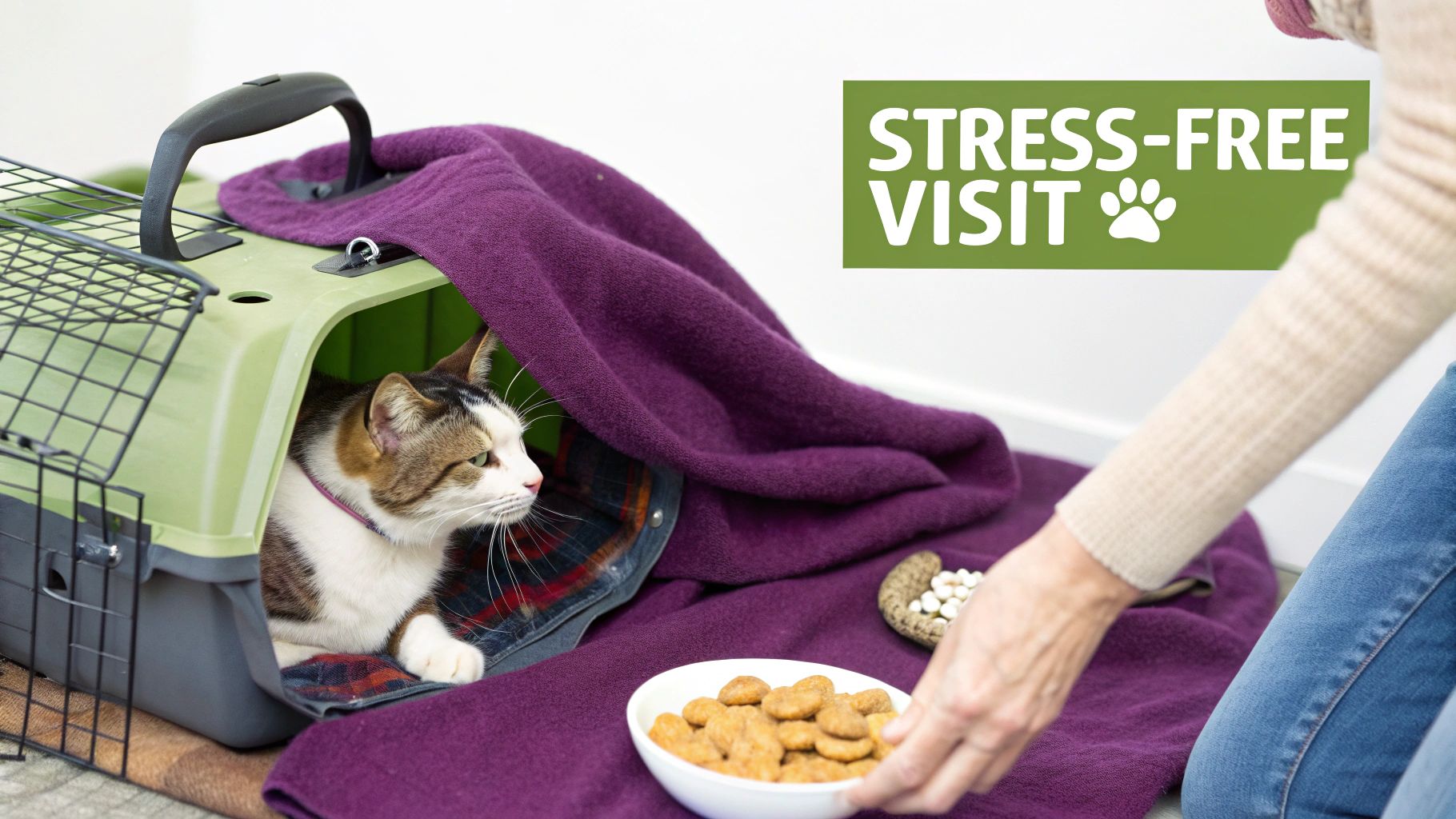
Start by leaving the carrier out in your living space all the time, with the door propped open. Make it ridiculously inviting. Toss in a soft blanket, a favorite toy, or even our CuddleCloud Calming Donut Bed.
Sprinkle some high-value treats near it, then inside it, and offer praise whenever your cat decides to investigate. The goal is simple: make the carrier just another awesome piece of furniture.
Of course, having the right gear helps. For a deep dive into finding the perfect one, check out our guide on how to choose the right cat travel carrier.
Prepping for the Vet Trip
It's no secret that vet visits are a major source of anxiety for cats. The unfamiliar smells, strange sounds, and being handled can trigger a massive fear response.
Here’s how to make the whole experience less traumatic:
- Practice Gentle Handling at Home. Get your cat used to the kind of touching they'll experience during an exam. Regularly touch their paws, ears, and mouth, always following up with a tasty treat.
- Be Your Cat's Advocate. Don't be afraid to ask your vet for a "fear-free" approach. This might mean using calming pheromone sprays on towels, examining your cat in the bottom half of their carrier, or just taking breaks if they seem overwhelmed.
Floofie’s Pro Tip: "My human always packs my favorite crunchy treats for the vet. When the nice doctor gives me one, it makes the whole poke-and-prod thing way less scary! Bribes totally work, just sayin'." 😉
Surviving Loud Noises and Parties
Fireworks, thunderstorms, or a house full of loud guests can send a nervous cat diving for the nearest hiding spot. The best strategy here is to create a secure "safe room" for them before the chaos even starts.
Pick a quiet room away from all the action. Stock it with their essentials: a litter box, fresh water, a comfy CuddleCloud Calming Donut Bed, and a few favorite toys. You can even use a white noise machine or play some calming classical music to help drown out the scary sounds from outside.
This gives your cat a peaceful retreat where they can feel safe and sound until the storm passes.
How Your Behavior Shapes Your Cat’s Well-Being
Ever notice how your cat seems to have a sixth sense for your moods? They're like little emotional sponges, and our own feelings—good or bad—can rub off on them more than we think. 🐾
You are one of the most powerful tools in your cat's anti-anxiety toolkit. By becoming their source of stability, you can learn how to reduce cat anxiety in a way that deepens your bond. 🧘♀️
Our connection with our cats is profound, and our mental state is a big part of that. A 2023 YouGov survey actually found that cat owners report higher lifetime rates of anxiety (30%) compared to dog owners or people without pets. This doesn't mean our cats give us anxiety, but it does suggest that many of us anxious humans are drawn to their calming presence. You can read more about the fascinating link between pet ownership and mental health in the full study.
This special bond is a two-way street. When we're stressed, our cats often pick up on it. Being a calm, consistent presence makes you the ultimate anchor in their world—a safe harbor in a sea of scary vacuum cleaners and surprise visitors!
The Power of Predictability
Cats are creatures of habit, through and through. They thrive on knowing what’s coming next, so a predictable routine is like a cozy security blanket for an anxious kitty.
When they know exactly when to expect meals, playtime, and your return home, it eliminates a huge chunk of uncertainty from their day.
- Consistent Meal Times: Feeding them at the same time every morning and evening builds an incredible amount of trust and security. Simple, but effective.
- Scheduled Play Sessions: Carve out specific times for a good play session. It gives them a healthy outlet for their energy that they can reliably look forward to.
- Bedtime Rituals: A gentle petting session or a specific treat right before bed can signal that it's time to wind down safely for the night.
"My human knows that a chaotic schedule is my arch-nemesis! When my routine is on point, I can focus on more important things, like napping in a sunbeam." - Floofie ☀️
Speak Their Language with Positive Reinforcement
When you catch your cat being brave or calm, reward them!
Did they stay in the room while you had a friend over instead of diving under the bed? Offer a tasty treat. Did they explore that new cat tree without hesitation? Shower them with praise and a gentle chin scratch. This helps them learn that calm, confident behavior gets them the good stuff.
On the flip side, never punish fear-based actions. Hissing, hiding, or scratching out of fear is a cry for help, not a sign of a "bad" cat. Yelling or punishing them will only make their anxiety worse and can seriously damage your relationship.
Instead, focus on creating a safe retreat for them when they feel overwhelmed, maybe with a cozy CuddleCloud Calming Donut Bed tucked away in a quiet corner.
By managing your own stress and providing a predictable, positive environment, you're constantly showing your cat that their world is a safe place. You are their rock, their leader, and their ultimate source of comfort. 💖
Your Top Questions About Cat Anxiety
Got some lingering questions about your worried little shadow? Floofie gets it. Figuring out cat anxiety can feel like you're trying to solve a puzzle without all the pieces. Let's tackle some of the most common questions from cat parents just like you.
Sometimes, just getting clear, straightforward answers is the biggest step toward helping your cat feel safe and secure again.
How Long Does It Take to Reduce My Cat's Anxiety?
This is the million-dollar question, and the honest answer is: it depends. Every cat is an individual, and the timeline really hinges on their personality, what’s causing the anxiety in the first place, and how consistent you can be with the changes you make.
Some cats respond beautifully to a few simple tweaks—like more playtime and a new cat tree—and you might see a noticeable difference in a few weeks. For a cat with deeper-rooted fears, maybe from a past trauma, you could be looking at a journey of several months.
Floofie's Tip: "Focus on the small wins. Seriously. Did your skittish kitty actually stay in the same room with you for an extra minute today? That's a huge victory. Did they chase the wiggle toy for the first time in months? Celebrate it! Those tiny steps forward are what build lasting confidence."
If you've been trying everything for a couple of months and feel like you're hitting a wall, that's a good sign it's time to bring in professional help from your vet.
Will Getting Another Cat Help My Anxious Cat?
Oh, this is a risky one. While the idea of a friend for your lonely cat is sweet, it often backfires spectacularly. For an already anxious cat, bringing a new, unknown feline into their territory can pour gasoline on the fire, cranking up their stress and making behavior problems even worse. 🙀
As a general rule, Floofie never recommends getting a second cat solely to "fix" the first cat's anxiety. If you are committed to adding another furry member to your family for other reasons, the introduction process needs to be painfully slow and methodical. We're talking weeks, maybe even months, of careful, managed separation and scent-swapping to give it the best chance of success.
When Should I Talk to a Vet About My Cat's Anxiety?
Our motto is: when in doubt, call the vet. It's always better to be safe. But you should definitely book an appointment if your cat's anxiety is severe, pops up out of nowhere, or comes with any physical symptoms.
Make that call if you see any of these red flags:
- Extreme Behaviors: This isn't just hiding. We're talking about things like over-grooming to the point of creating bald spots or skin sores, or sudden, uncharacteristic aggression toward you or other pets.
- Sudden Change: If your normally cool-as-a-cucumber cat is suddenly a bundle of nerves overnight, a medical issue could be the culprit.
- Physical Symptoms: Things like a sudden loss of appetite, weight loss, or peeing outside the litter box aren't just "behavior." They can be signs of underlying health problems that are causing pain or discomfort, which then looks like anxiety.
Your veterinarian can run tests to rule out any medical conditions first. If it is truly behavioral, they can discuss options like calming supplements, prescription anti-anxiety medication, or even refer you to a certified veterinary behaviorist for a more tailored plan. You're not in this alone! And for more general info, the Purrlys FAQ page is another great resource.
At FloofChonk, we're all about celebrating the feline-focused life with flair and fun. From cozy calming beds that soothe anxious kitties to quirky apparel that shows off your cat pride, we've got everything you need to spoil your best fur-end. Explore our collections today and find the purr-fect gear for you and your floof! Find your new favorite thing at https://www.floofchonk.com.
